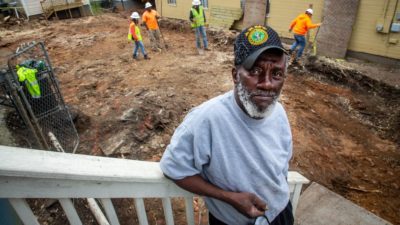By Drew Kann, Shelia Poole and Nick Thieme
This article is reprinted courtesy of The Atlanta Journal-Constitution
Lanetra Tucker used to live in an apartment just a block away from Crawford W. Long Middle School. Most days, her children made the short walk to and from the campus in south Atlanta, in the shadow of Hartsfield-Jackson International Airport.
But she said she never noticed the plant just up the hill from the school, where mounds of dirt-like waste were left exposed to the elements.
Last month, the Environmental Protection Agency issued an emergency order that lead and other pollutants from the metal processing plant may pose an “imminent and substantial” danger to the public. Environmental experts say it could be the city’s next Superfund site, requiring a massive cleanup.
The federal agency found the area surrounding the TAV Holdings plant ranks above the 80th percentile in Georgia for many environmental health indicators, including cancer risk and respiratory hazards. The neighborhood is mostly home to lower-income people of color.
“It just doesn’t surprise me,” said Tucker, the parent of a current eighth grader at Crawford Middle, where the EPA collected soil samples. “Stuff like this is something that Black people have gotten used to.”
For decades, communities of color across the U.S. have faced a disproportionate burden from environmental threats. The case unfolding in Atlanta’s Glenrose Heights neighborhood and a Superfund cleanup underway in nearby Vine City, another mainly Black community, suggest Georgia is still reckoning with a history of environmental injustice.
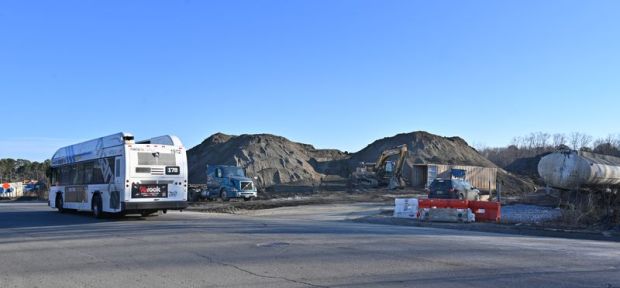
Research has found that polluting industries are more likely to locate in minority and low-income neighborhoods. And people of color are more likely to breathe air with high concentrations of fine particulate pollution, which is responsible for tens of thousands of deaths each year across the U.S.
An Atlanta Journal-Constitution analysis of EPA and Census Bureau data found Georgia Census tracts within two miles of a Superfund site had a larger percentage of Black residents and lower home values, on average, than neighborhoods farther from the sites in the same county.
Sites with the EPA’s Superfund label are among the most toxic in the country. Superfunds can also be placed on the program’s National Priority List, meaning the agency has found the site will require long-term cleanup. Georgia has 18 sites that are on the NPL or have been proposed to be added.
About 44% of the residents living in Census tracts surrounding those 18 Superfund sites are Black, compared with 31% elsewhere. Homes within two miles of a Superfund site are also worth just $112,000 on average, compared with $165,000 farther away, according to the AJC analysis.
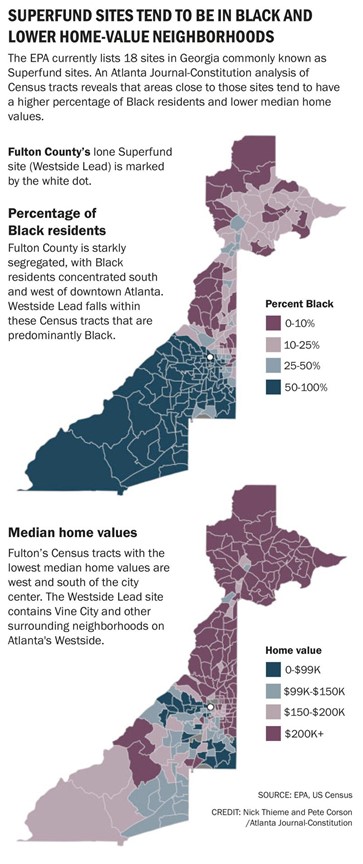
Fatemeh Shafiei, a former member of the EPA’s National Environmental Justice Advisory Council, calls environmental justice the civil rights of the new millennium.
Long before the 2020 protests against racism in the wake of George Floyd’s killing, many Black communities “were already struggling with ‘I can’t breathe’ because of asthma,” said Shafiei, a Spelman College professor. “Blacks are disproportionately affected by asthma because they live in areas that are very close to pollution.”
According to the Environmental Defense Fund, air pollution alone accounts for more than 6 million premature deaths each year from heart attacks, strokes, diabetes and respiratory diseases, such as lung cancer. The detrimental effect of contamination, heat and air pollution make for bad pregnancy outcomes, especially for Black women.
And lead, like that found escaping from the TAV plant, is a potent neurotoxin that can cause damage to the brain and the nervous system, particularly in children.
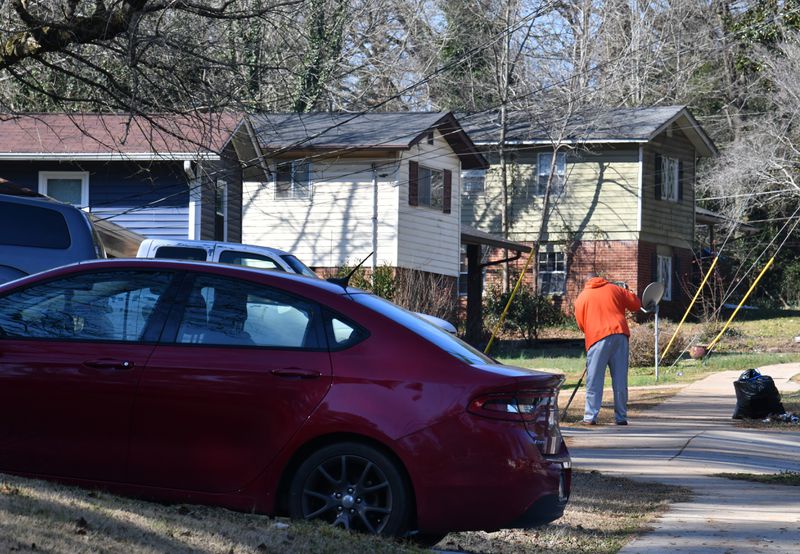
Health concerns persist in Newtown
On Desota Street, in the predominantly Black Newtown neighborhood of Gainesville, rests a granite monument engraved with the names of 20 residents who died of cancer from the 1980s to the early 2000s.
Some were members of the Newtown Florist Club, which was formed in the 1950s by a group of Black women who helped the sick and collected donations to buy flowers for the funerals of residents.
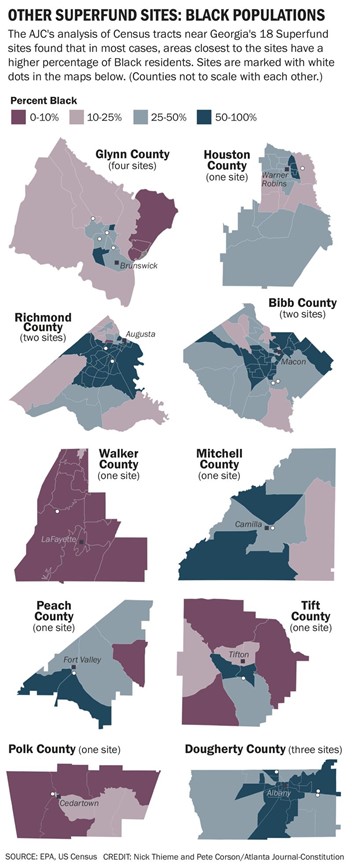
Sometimes residents would notice an odd smell coming from some of the nearby businesses. Over time, said the Rev. Rose Johnson, the current executive director, members of the club noticed that many of the residents were suffering from cancer, lupus and various respiratory illnesses.
Their homes, built for Black families displaced by the 1936 tornado that destroyed large swaths of the city, were built on top of an old landfill. Years later, industrial plants would locate in the area.
The club’s members became advocates for environmental justice and civil rights, documenting illnesses and deaths.
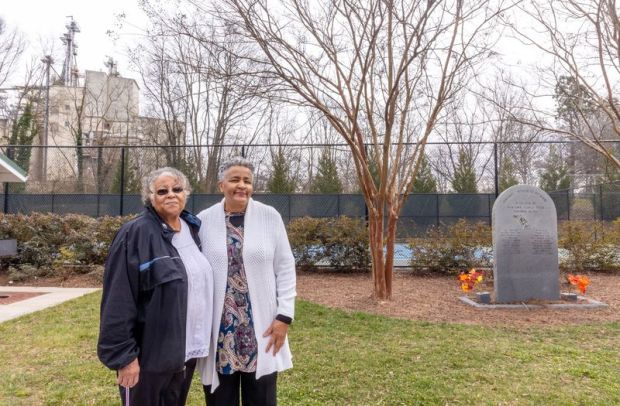
Johnson’s family moved to the closely knit community when she was 12. She recalls playing outside and coming home with her hair and clothes covered in a fine yellow dust.
Those who could move away did. Others decided to stick it out, not willing to leave family and friends and unable to afford to do so.
In 1990, the state Department of Human Resources confirmed a higher rate of throat and mouth cancers in the neighborhood. But the state office of epidemiology later attributed the high rate to a lifestyle of smoking and drinking, which outraged residents, according to Ellen Griffith Spears, author of “The Newtown Story: One Community’s Fight for Environmental Justice.”
Two later public health assessments conducted by the Agency for Toxic Substances and Disease Registry did not find enough evidence to link health problems in Newtown to pollution.
But independent environmental consultants questioned the agencies’ findings. Over the last 20 years, Georgia’s Environmental Protection Division has executed five consent orders involving facilities around Newtown for a variety of issues, including air quality violations.
Jamie Baker Roskie, the former managing attorney at University of Georgia’s Land Use Clinic, spent years studying Newtown and says she understands why residents feel unheard.
“The conversation seems exactly the same as it was a decade ago or 20 years ago … It doesn’t feel like any real solution has been offered to those residents,” Roskie said.
Today, although some of the nearby industries have addressed concerns, Johnson wonders if younger generations who grew up in Newtown will have similar health problems.
“Any community like ours that has fought against or addressed environmental contamination has to pay attention to the long-term generational affects. You wonder will they be next?”
‘Little has changed’
Robert Bullard is known as the “Father of Environmental Justice.” In 1994, he launched the Environmental Justice Resource Center at Clark Atlanta University.
He followed in the footsteps of the Rev. Benjamin F. Chavis Jr., who is largely credited with popularizing the term “environmental racism” in the 1980s while director of the United Church of Christ’s Commission for Racial Justice.
Over the last few decades, “little has changed in terms of fighting for equal justice when it comes to things like location and land usage,” said Bullard, the author of “Dumping in Dixie: Race, Class and Environmental Quality.”
“America is segregated and so is pollution,” added Bullard, now a professor at Texas Southern University.
He says it’s not just about income, because white people may find it easier to move than Black people because of housing discrimination, redlining and unfair practices in the real estate industry.
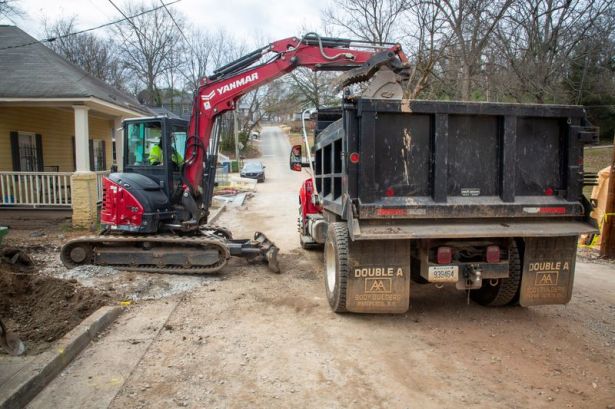
Westside tries to dig out from past
Standing at the top of the stairs that lead to his front door, Ellis Smith watches as an excavator digs up his yard.
Using the machine’s claw to scoop up loose dirt, the operator empties loads of dark sediment into the bed of a waiting dump truck. When the black dirt gives way to Georgia’s trademark red clay, he moves on to the next tract.
The cleanup of Smith’s yard is part of a massive EPA effort underway to remove lead from hundreds of Vine City properties, which comprise the Westside Lead Superfund site.
Experts say it’s unclear exactly how dangerous levels of lead got in the soil beneath this historic Black community, where Martin Luther King Jr. once lived, but say it is likely from metal foundries that were once common on Atlanta’s Westside.
After an Emory professor and her students found high levels of lead in the neighborhood in 2018, the EPA began sampling on 60 properties in March 2019. Today, the site has grown to include 2,100 properties, according to Leigh Lattimore, the EPA’s remedial project manager for the site.
While remediation work on the Westside could last until 2028 or 2029, the task of rebuilding trust in communities that have been affected by pollution could take much longer.
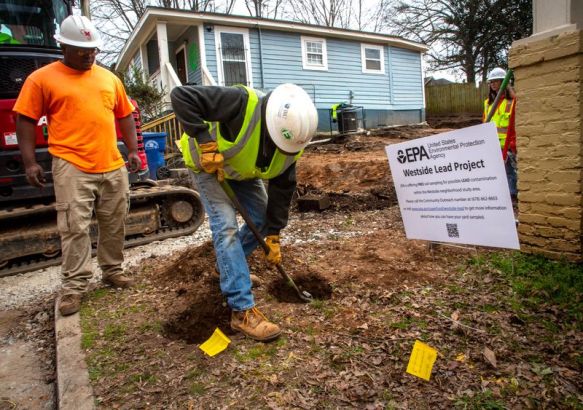
Daniel Blackman is well aware of this challenge. He was recently named the EPA’s administrator for Region 4, which includes Georgia and seven other Southern states. He is the first Black male to serve as an administrator for the region.
Blackman said the agency needs to take the time to listen and engage with affected communities, but also hire people who look like those they serve.
Just around the corner from Smith’s house, Octavious O’Neal’s yard looks far different. Instead of a mess of clay and tangled tree roots, O’Neal’s yard has sod, fresh mulch and new hedges along the fence line, after the EPA cleaned it up late last year.
“We’re finally getting the justice that we deserved a long time ago,” he said. “That wrong is being righted here and I hope in other parts of the city, the same thing happens.”
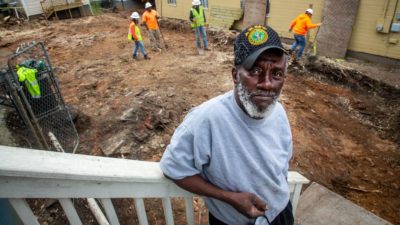
—Digital audience specialist Pete Corson contributed to this article.

